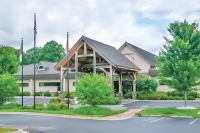Avian nomads
I have just finished by bird point survey for the Forest Service, which takes me to Mt. Mitchell and Roan Mountain. It’s a chance every year to get reacquainted with Western North Carolina’s high-elevation nesters.
The diminutive golden-crowned kinglet, with its big voice, is common among the conifers at both locales. The nasal “yank yank yank” of the red-breasted nuthatch rings in the forest. In some places the lovely rising flute song of the hermit thrush is more common than the downward slurred “veeer-uur” of the veery. The seeps and wet rocky mountainsides fairly gurgle with the bubbly song of the winter wren and pine siskins roam the high terrain in small flocks.
Another high-elevation specialist here in the mountains of WNC is the red crossbill. This cosmopolitan feathered nomad is unique in several ways. This stocky, sparrow-sized finch has a large head and a thick, heavy beak. The upper and lower mandibles taper to curved, pointy tips that cross. This beak is adapted for prying the seeds of pines, firs, spruces and other conifers out of the cone.
Males are a dull brick red with darker, brown wings. Some first-year males are orange and the wings show narrow, light wing-bars. The females are olive-green above and yellowish below with dark wings. Juveniles are olive-brown above and heavily striped below.
Red-crossbills are often seen climbing around parrot-like in conifers searching for cones full of seeds. The crossbill starts at the bottom of the cone and spirals its way upwards prying apart the scales with its curved mandibles and plucking the seed out with its tongue. Some crossbills are left-beaked (mandibles cross to the left) and some are right-beaked. This determines which direction the bird spirals around the cone.
Red crossbills are found in Europe, Asia, northern Africa, across the North American continent from coast to coast, from Alaska south to New Mexico in the west, through the Rocky Mountains to New England and the Adirondacks and down the Appalachians to North Carolina and northern Georgia.
Related Items
They are truly nomadic, following the abundance of conifer seeds in single-species flocks and are often found wandering far outside of their normal range in search of food.
Like all nomads, food is the key to their existence. When abundant food is found, crossbills will settle in and begin to nest even if it’s winter. Pairs are monogamous within flocks and the female builds a bulky cup-like nest of twigs and bark strips lined with lichen and hair.
Speed is the key to this nomadic family life with the female incubating usually three eggs for about two weeks and the young ready to leave the nest in 15 to 20 days. There may be multiple broods if the food source is abundant.
The red crossbill is a highly variable species with eight or nine different races or types. Some biologists believe some of these types may be separate species. Types differ subtly in voice and size and when different types come together in search for food they generally remain segregated when it comes to breeding. Types 1 and 2 are apparently the most common types in the Southern Appalachians.
Their fondness for salt often results in road kill along our northern highways. Employees at Mt. Mitchell used to put salt licks outside the restaurants windows but bears caught on and the practice had to be stopped. The best views I have ever gotten of red crossbills were while sipping coffee at the restaurant.









